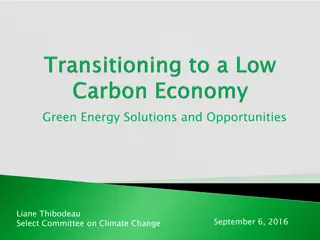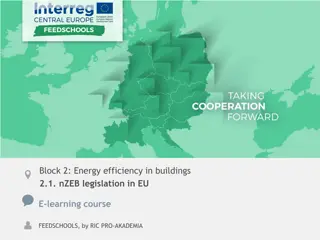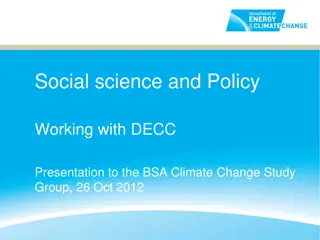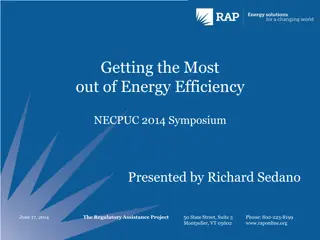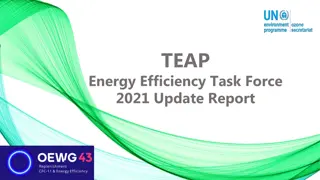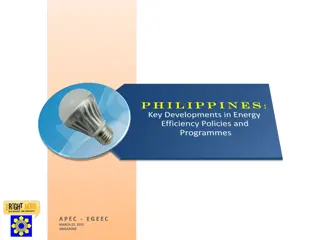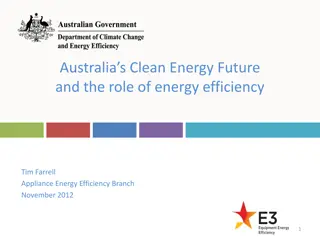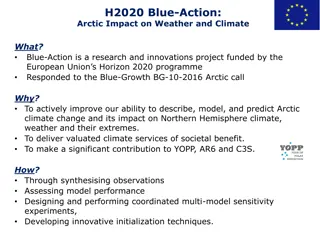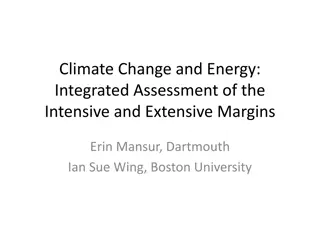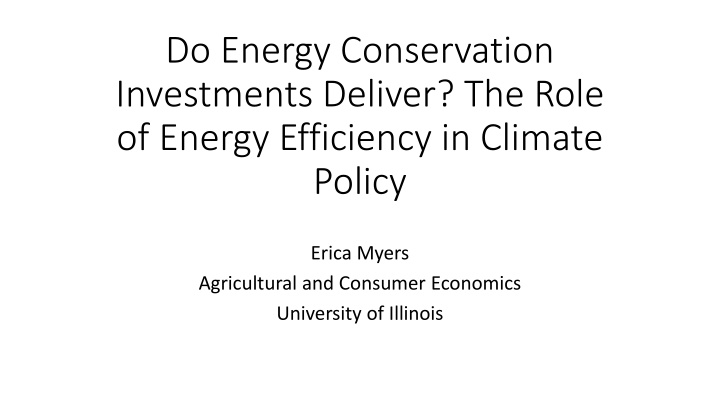
Energy Efficiency for Climate Action
Energy efficiency plays a crucial role in reducing carbon emissions and achieving climate goals. Government policies, investments, and initiatives emphasize the importance of energy conservation. Key policymakers and significant financial resources are directed towards energy efficiency programs to drive environmental sustainability and cost savings. Various studies highlight the effectiveness of energy efficiency measures in curbing greenhouse gas emissions. This content discusses the role of energy efficiency in climate policy and the substantial impact it has on mitigating global warming.
Download Presentation

Please find below an Image/Link to download the presentation.
The content on the website is provided AS IS for your information and personal use only. It may not be sold, licensed, or shared on other websites without obtaining consent from the author. If you encounter any issues during the download, it is possible that the publisher has removed the file from their server.
You are allowed to download the files provided on this website for personal or commercial use, subject to the condition that they are used lawfully. All files are the property of their respective owners.
The content on the website is provided AS IS for your information and personal use only. It may not be sold, licensed, or shared on other websites without obtaining consent from the author.
E N D
Presentation Transcript
Do Energy Conservation Investments Deliver? The Role of Energy Efficiency in Climate Policy Erica Myers Agricultural and Consumer Economics University of Illinois
Energy Efficiency often touted as one of the most cost effective way to reduce GHGs Source: McKinsey and Company, Pathways to a Low-Carbon Economy, 2010
Key Policy Makers on Energy Efficiency For the next few decades energy efficiency is one of the lowest cost options for reducing U.S. carbon emissions. Many studies have concluded that energy efficiency can save both energy and money. -Former Secretary of Energy, Steven Chu I'm also issuing a new goal for America: let's cut in half the energy wasted by our homes and businesses over the next twenty years..." -President Obama, State of the Union Address, February 2013 Energy efficiency...it's going to be the focal point of my time as secretary" -Ernie Moniz, Secretary of Energy
Big Money Spent on EE The American Recovery and Reinvestment Act $97 billion in energy related funding $32 billion of which went to energy efficiency and retrofits (U.S. Congressional Budget Office, 2009) LBNL Analysis of Utility Customer Funded EE Spending $5+ billion spent annually Spending will almost double by 2025 (Barbose et al., 2013)
Energy Efficiency is a Significant Component of Prominent GHG Policies
Massachusetts Global Warming Solutions Act of 2008: more than 1/3 reductions from EE improvements to buildings and appliances
Almost 15% of GHG reductions from Californias AB 32 projected to come from building and appliance efficiency programs Source: CARB, Greenhouse Gas Reductions from Ongoing, Adopted and Foreseeable Scoping Plan Measures
How is EE Potential Calculated? Source: McKinsey and Company, Pathways to a Low-Carbon Economy, 2010
How is EE Potential Calculated? Difference in Life Cycle Cost between standard and efficient appliances Life Cycle Cost has two components 1)Purchase and installation cost 2)Operating costs summed over life time
Research Agenda For Economists Why aren t these seemingly cost effective measures being taken up in the absence of public policy? i.e. If there are dollar bills on the ground, why is no one picking them up?
Can We Identify Market Failures that Lead to Sub-Optimal Investment? Non-optimizing Behavior Inattention Saliency Effects Status Quo Bias Principal-Agent Problems
Projected Savings Typically Over-Estimate Realized Savings Weatherization Assistance Program (Fowlie et al. 2015) Appliance rebate programs (Houde and Aldy 2014, Davis et al. 2014) Building codes (Levinson, 2015).
What is driving the wedge between projected and realized savings? Workmanship Occupant behavior Modelling
Can We Blame the Workers? 450 100% 400 80% 350 300 Net Savings 60% 250 200 150 100 50 Source: Blansnik 2013 0 0 50 100 150 200 250 300 350 400 450 Average Projected Savings
Can We Blame the Occupants? Some say actual energy use has little to do with house efficiency because effects of particular occupants can have such a large effect Hard to measure occupancy impact, Blasnik 2013, tries to bracket it
Blasnik 2013s Approach Analysis of Midwestern gas utility customers Weather-adjusted gas use in 2012 vs. 2009 Owner-occupied single family homes Results for 79,805 movers and 545,136 stayers
Gas Use: Movers vs. Stayers 100% 90% Absolute % Difference in Gas Use 80% 70% 60% 50% 40% Movers 30% 20% Stayers 10% 0% 0% 0% 10% 20% 30% 40% Median 60% Percent of Homes 70% 80% 90% 100% Source: Blansnik 2013 Median Abs. Change in Gas Use: Movers=15%, Stayers=8% Within 25% of prior use: Movers=71%, Stayers=90%
How About Modelling? Engineers do a pretty good job with newer, efficient houses Energy consumption and the effect of EE improvements of existing housing stock much harder to predict Ex-post evaluation of the realized savings from these measures could help to calibrate the models and increase accuracy
720 Energy Star New Homes in Midwest Actual vs. Projected Gas Heating Usage +20% 1400 Actual Gas Heating Use 1200 1000 -20% 800 600 400 200 0 0 200 400 Projected Gas Heating Use (REM) 600 800 1000 1200 1400 Source: Blansnik 2013 N=-720 Energy Star homes Mean heating use = 656 projected, 662 actual, median abs % error=16% 60% of homes used within 20% of projection 17% of homes used >20% more, 23% of homes used 20% less REM-projected avg. heating use 656 vs. 662 actual Typical (median) discrepancy= 16%
Houston Energy Star Homes Study actual vs. predicted cooling 10,258 homes Lots of scatter 17% Median diff 16000 Actual Summer/Cooling Load kWh/yr 14000 12000 10000 8000 6000 4000 2000 0 0 2000 4000 6000 8000 10000 REM-Projected Cooling Load kWh/yr Source: Blansnik 2013
Modeling Existing Homes: Wisconsin Home Energy Rating System (HERS) Study Projected use 22% high on average badly overestimated for inefficient homes Source: A Rating Tale , S. Pigg, Home Energy Magazine Jan/Feb 2001
California Home Energy Efficiency Rating Services (CHEERS): 1997 No relationship between rating and actual energy usage intensity !? Source: Accuracy of Home Energy Rating Systems LBNL 40394 study, J. R Stein 1997
Takeaways Energy Efficiency is here to stay in climate policy and utility programs Program goals can be undermined if EE not properly accounted for More ex-post analyses needs to be done to compare projected to realized energy consumption from EE measures As more studies estimate realized savings on a per measure basis, we can decompose the wedge and try to better predict energy efficiency benefits for public policy




